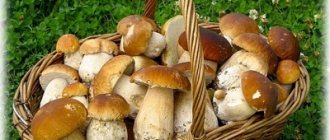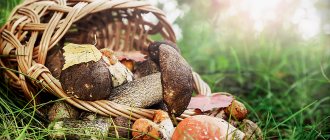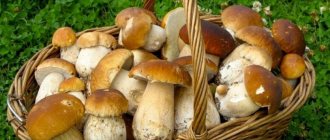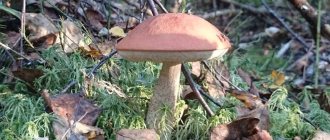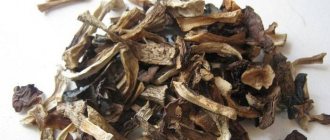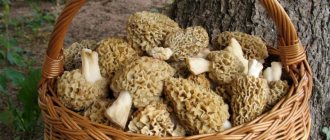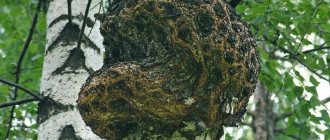Despite the harsh northern climate, the nature of Karelia is very generous. Rivers and lakes are full of fish, and wild animals abound in the untouched forests. More than 270 species of mushrooms grow in local forests.
It will take a lot of time to describe the diversity of Karelian mushrooms. Therefore, we will analyze only the popular edible species - those that local residents collect for themselves. It will also be useful for lovers of “silent hunting” to learn about the season and features of mushroom picking in Karelia.
White mushroom or boletus
It is considered the most noble mushroom and the most desired prey for mushroom pickers. It cannot be confused with toadstool, like other edible mushrooms, and it is good for any processing. Porcini mushrooms can be dried, boiled, fried, salted and pickled. Its peculiarity is its high content of vegetable protein, comparable in value to animal protein.
It is better to look for such mushrooms in Karelia in open clearings in mixed or coniferous forests, where dry soil with sandy soil predominates. The white one grows in groups, so when you find a boletus in the forest, carefully check the area around you - you will probably notice other members of its family nearby.
Collection of porcini mushrooms in Karelia is carried out all summer - from mid-June to the end of August. Usually at the beginning of the season there are few boletus mushrooms in the forest, but by the end of summer their number increases.
Memo for mushroom picker
To avoid poisoning when collecting and storing mushrooms, you should follow the following safety rules:
- Do not collect mushrooms in bags or bags.
- Take only those species that you know for sure.
- Do not collect old and wormy mushrooms.
- If, after coming home, you find poisonous mushrooms among the edible mushrooms, you should throw away all the mushrooms.
- You cannot take mushrooms along roads or in cemeteries.
- It is advisable to cook the crops on the day of collection, as they quickly deteriorate.
- You cannot feed mushroom dishes to preschool children - their bodies do not have the enzymes necessary to digest this product.
- Harvesting rules should be carefully followed.
Don't waste your time and go to the forest for a rich harvest! There are plenty of mushroom places in the vicinity of our park hotel.
And if you want to combine business with pleasure, then we can organize for you a real “mushroom safari” - a boat trip on Ladoga to the islands to pick mushrooms. Very few mushroom pickers get there, so the mushroom harvest there can be truly impressive.
Boletus
A worthy rival to boletus in terms of taste. Boletus is good in any form, but traditionally it is believed that it is better to fry it with new potatoes - this way its rich taste is better revealed. The color of the cap of the boletus varies from bright orange to dark red, the leg is spotted, with oblong black spots.
If the forecast for the mushroom harvest in Karelia does not meet your expectations in the production of boletus mushrooms, then an encounter with boletus mushrooms is more likely. Unlike the porcini mushroom, the boletus mushroom prefers moist soil, so you need to look for it closer to the swamps, in darker places. Boletuses can also be found on dry soils, but much less frequently. They grow in groups, but not as numerous as boletus mushrooms.
Where to look for mushroom places?
Beginning mushroom pickers and guests from other regions of the country are wondering - where are the mushrooms in Karelia? After all, you want to not just pick one or two specimens, but to fully enjoy the hunt. To begin with, it is worth noting that mushrooms gradually migrate. And if earlier boletuses, chanterelles and saffron milk caps settled in the south of Karelia, now they are found much further north.
Today Pryazhinsky is considered the most mushroom district of the region. These are places near Syamozero, Vedlozero and Kroshnozero. As well as the surroundings of the villages of Syapsya and Chuinavolok. The Loukhsky district has its own good place - the shores of Lake Engozero. In Prionezhskoye there is an area near a forest nursery. In Segezhskoe - the vicinity of the village of Nadvoitsy. And in the Belomorsky district - the banks of the Okhta River, the village of Maslozero and the village of Letnerechensky. Experts also recommend visiting the villages of Girvas, Luchevoy and Krasnaya Rechka in the Kondopozhsky district. And be sure to stop by the village of Sopokha not far from the Kivach waterfall, where many selected specimens grow in the protected area.
boletus
In the Karelian forests there are two types of boletus: common and pinkish. In appearance, they differ from each other only in the color of the cap. You need to look for these mushrooms in dry birch groves or mixed forests. Although pink boletus can also be found in damper areas, in the highlands and tundra, not far from dwarf birches, this does not happen often.
Interesting fact: it is impossible to predict where these mushrooms will go next season in Karelia. Their yield is unpredictable. In the high year, boletus mushrooms literally fill the Karelian forests. But already in the next season they can suddenly disappear, and after a couple of years they can return in even greater numbers.
Berries of Karelia
- The cloudberry berry season opens; the harvest time for this berry is July.
- The red, fragrant, very tasty strawberry is harvested in July.
- The healing, very tasty blueberry begins to ripen at the end of July and August.
- The eternal companion of wild rosemary, the large blueberry, is ready for harvest in August.
- The time to collect tasty and healthy lingonberries begins at the end of August.
- A storehouse of vitamin C, the large bog cranberry ripens in September.
Blueberry
. Blueberry bushes (up to 45 cm high) grow for about 30 years. You can find the berry in shady places; sometimes you come across blueberry bushes in clearings, and there it is especially sweet. Fresh, frozen or dried berries have a beneficial effect on vision and are used for gastrointestinal diseases. Blueberry leaves are used for diabetes. Blueberry juice has bactericidal properties. Cloudberry. This herbaceous, tender plant, 30 cm high, grows in swamps, adjacent to cranberries and lingonberries.
Cloudberry
afraid of rain, strong winds, frosts. The fruits are high in vitamin C and A, and cloudberry leaves and sepals promote wound healing and have an anti-inflammatory and hemostatic effect.
Cowberry.
A low shrub - about 15 cm (sometimes up to 40 cm) can be found everywhere. Lingonberry and cranberry juices have disinfectant, diuretic, antiseptic, and antipyretic properties.
Cranberry.
This creeping shrub is found primarily in swamps or wetlands. Cranberries contain rare vitamin K1, as well as vitamin C in large quantities. Eating cranberries helps eliminate heavy metals from the body. You can store cranberries until spring by simply filling them with water.
Both adults and children will enjoy picking mushrooms and berries in the purest Karelian forests!
Oil can
There are a lot of subspecies of butter, but the most common one is the real butter dish or the yellow butter dish. By its appearance in the forests you can usually tell whether there are mushrooms in Karelia. If there is an oil can, then other types are more likely to come across.
The mushroom grows in large groups in coniferous forests, prefers sandy soil and bears fruit from mid-summer to late autumn. It was nicknamed the buttercan because in wet weather its cap seemed to be greased with oil due to the mucus formed.
Butterfly is not much inferior in taste to other mushrooms and is good in any form: dried, boiled, fried, salted and pickled. It is easy to digest and is considered one of the most delicious edible mushrooms. When preparing it, it is better to remove the skin from the cap so that the mushroom is not so slippery.
Edible mushrooms in Karelia 2022, photo
The list of edible and conventional species includes more than 250 species of mushrooms. True, more than 20 of them are on the verge of extinction. They are listed in the Red Book and are protected in nature reserves. Collecting these rocks will result in a heavy fine...
Despite the large list of edible mushrooms, most fruits can be classified as conditional, requiring careful heat treatment and preparation. If you ignore the list of recommendations, you can get food poisoning, stool upset, vomiting and even intoxication of the body.
In 2022, mushroom pickers will collect the most:
- little girls;
- varieties of milk mushrooms;
- chanterelles;
- saffron milk caps;
- boletus;
- honey mushrooms;
- morels and lines;
- White mushrooms;
- flywheels.
The largest and most delicious are porcini mushrooms. Their length can reach 30-35 cm, and the diameter of the cap is 15-25 cm. The color scheme is almost always the same, but can vary in shades. Most often found: brown, brown and dark cherry boletus, less often specimens with white, beige and lemon caps.
Obabki, as in other regions, grow throughout Karelia. They can be found in any deciduous and coniferous forest if birch and aspen trees grow there. Among the varieties, several types of boletus can be distinguished: swamp, pinkish and even “classic”, familiar to many.
No less popular among mushroom pickers in Karelia in 2020 is a conditionally edible species that requires careful heat treatment. Milk mushrooms, unlike other mushrooms, should be soaked in water for several days and then cooked.
The most striking feature of the butterfish is its thin mucous film. It helps to distinguish an edible species from a conventional and poisonous one, despite the fact that during heat treatment it is removed from the cap with a knife. These mushrooms often grow in coniferous forests, less often in tall grass and mixed forests.
Chanterelles, moss mushrooms and honey mushrooms are collected by many mushroom pickers. True, while some people collect them for making soups and preparations for the winter, others prefer more interesting cooking methods. We are talking about delicious homemade spreads, suitable for light but satisfying sandwiches.
Morels and strings are collected more often in the first months of spring, after the snow melts on the thawed ground, when the sun's rays are just beginning to warm the soil. And if the first ones have a cylindrical cap shape, the second ones are more reminiscent of the shape of a human brain, reduced several times. You can find them in young pines and spruces...
Chanterelles
Mushrooms with recognizable shape and color. They grow in large groups, which makes the process of collecting them easier. You need to look for chanterelles in coniferous or mixed forests. There they grow both in open soil and deep in the taiga mosses, under the leaves.
But if you see a bright orange mushroom on a fallen tree, it is better not to cut it off. It could be another mushroom that disguises itself as a real chanterelle - orange talker or false chanterelle.
Those who are interested in whether there are chanterelle mushrooms in Karelia now should pay attention to the month of their planned collection. Chanterelles can be found in forests from June to October. As for the false mushroom, it grows from late summer to late autumn.
Important! The caps of false chanterelles are usually very brightly colored, unlike true chanterelles, which are closer to yellow-orange than red. In addition, these mushrooms differ in the shape of their cap. False chanterelles will have smooth and rounded edges, but a real chanterelle will often have an irregularly shaped cap.
However, the surest sign that helps to distinguish a real fox from a talker is worminess. Insect larvae can only live in false mushrooms, because real ones secrete a special substance - chitinmannose, which kills helminths.
Therefore, if among a group of mushrooms you come across a wormy chanterelle, then this is not the mushroom that you need. In general, false chanterelles are conditionally edible mushrooms. After three days of soaking in water and heat treatment, they can be eaten. However, the taste of such mushrooms will be inferior to the taste of real chanterelles.
Fantastic mushroom harvest in Karelia. The best samples (photo)
We present a selection of mushroom photographs taken in Karelia this year and seasoned with interesting comments. Send us your photos to show off!
White and red, red and dark. I'm not talking about girls, about mushrooms. We have collected for you a selection of interesting photographs that were taken in Karelia this summer and autumn and posted on social networks.
This summer in Karelia was hot and not rainy, so no one expected such a yield of mushrooms. As someone joked on social networks, the situation is such that mushrooms themselves come out onto the road, wondering why no one is picking them. And for those who do collect, sometimes the interior of the car is not enough.
Let's look at these fees. Like the photos (green triangle at top right) that you like. By the way, if you also have good photos on the topic, send them to [email protected] with the subject “mushroom stories.” Don't forget to provide a comment on the photo about where and how it was taken.
Author: Valentina Platonova
In journalism since 2008. She wrote for the newspapers “Everything”, “TVR-Panorama”, the magazine “Your Leisure”, and was the editor of the magazine “Telepult”. Likes to look for mushrooms and interesting topics.
Milk mushrooms
Traditional Russian mushroom. In Rus', milk mushrooms were called the “king of mushrooms”; it was considered the only mushroom suitable for pickling. But in the West, milk mushrooms are still considered inedible.
Real milk mushrooms grow in large groups, but at the same time they are not easy to find, since they are not common. But if you’re lucky, a successful mushroom picker in a good year can carry away up to several buckets of milk mushrooms from one clearing. The harvesting season for these mushrooms is from July to September. You need to look for milk mushrooms in birch or pine-deciduous forests, where they hide in last year’s leaves and needles.
To find out whether mushrooms have grown in Karelia, it is better to talk with local residents. They probably won’t show you the way to the mycelium, but they will definitely tell you about the appearance of mushrooms in the forest, including which ones.
Mushroom Karelia, what are the riches of the region?
Despite its northern location, the region is famous for its extensive natural resources. High humidity, combined with mild winters that replace warm weather, makes it possible to annually harvest large harvests of edible mushrooms, suitable for preparing all kinds of dishes, freezing, drying and pickling for the winter.
Even in the sultry hot summer, when drought comes to the region, local residents do not complain about the lack of mushrooms. Fruiting occurs as if on schedule, thanks to the presence of large amounts of water resources in the region. High humidity is associated with an extensive coastline that runs through about 25 thousand rivers and 55 thousand lakes.
Almost the entire territory of Karelia is forested. More than 80% of the entire territory is occupied by coniferous forests, less often by deciduous forests. There are few mixed deposits, so mushroom pickers should decide before their trip which mushrooms are most preferable.
In the summer, namely June, July and August, when going out in search of mushrooms, local residents and visiting guests can collect not only mushrooms, but also other equally useful forest products: hazelnuts, blueberries, blueberries and raspberries. In rare cases, hazel may catch your eye.
When to go mushroom picking
The first mushrooms appear here in April. These are morels, they can be found in deciduous forests and are recognized by their peculiar bell-shaped “cap”. Due to the content of helvelic acid, morels are classified as conditionally edible. In order to use them for food, you need to boil them and be sure to drain the water. During cooking, the acid remains completely in the broth. In addition, helvelic acid disappears when morels are dried. At the end of spring, oyster mushrooms and puffballs appear.
Mushroom picking in Karelia.
But the main hunting season for the most valuable summer mushrooms begins in July - August and lasts until the end of September. Boletus mushrooms, boletus mushrooms, russula, fly mushrooms - they can be found in birch and pine forests. There are many chanterelles and boletuses in aspen groves. At the very end of June, noble porcini mushrooms begin to appear. They are hunted in pine forests, spruce forests, and oak groves. They usually have a round, dark-colored cap and a short, fleshy leg. Fresh porcini mushrooms have virtually no odor, but when dried they emit a pleasant aroma. In July, the first milk mushrooms appear and housewives begin to prepare pickles. It is believed that the most delicious mushroom for pickling and marinade is the milk mushroom.
More than 40,000 books, all popular genres, communication with authors, convenient mobile version.
In the spruce forests, mushroom hunters will find saffron milk caps, another species traditionally used for pickling. August gives mushroom pickers everyone’s favorite chanterelles – bright yellow in color with an original cap shape.
Many lovers of “quiet hunting” come to this area in early autumn, when there is a large selection of mushrooms and the weather is conducive to forest travel. Fans of active recreation and walks in the forests choose a holiday in Karelia in early autumn - during this period the leaves on the trees play with all their colors and you can enjoy the unique landscapes of the northern forests in the early autumn period.
Forests of Karelia.
What poisonous mushrooms are there?
Many mushroom pickers think that only poisonous mushrooms can cause harm. But this statement can be disputed! If you carefully study the statistics of poisoning, you can say for sure that the following can harm the body:
1) inedible mushrooms; 2) conditionally edible fruits, prepared with neglect of heat treatment and cooking, can cause intestinal upset, vomiting and weakness of the whole body. 3) edible mushrooms can also cause poisoning if they were collected and cooked together with poisonous fellow mushrooms. Health problems can also be caused by such circumstances as: germination near the highway and road, where cars often pass and release carbon dioxide into oxygen, germination of mycelium in cemetery areas contaminated with organic substances (cadaveric poisons).
The list of the most poisonous and inedible mushrooms includes:
- varieties of Amanita (translated from Latin as fly agarics);
- Amanita phalloides or pale grebe;
- gall and satanic mushroom;
- bloody tooth;
- pink wave
Unlike many mushrooms that are harmful to the body, Bloody Tooth began to sprout in the vast expanses of Karelia not so long ago. Its history in Russia began in the 2000s. It previously grew in southern Finland. This mushroom can poison the body and lead to death, even if you eat a small piece.
